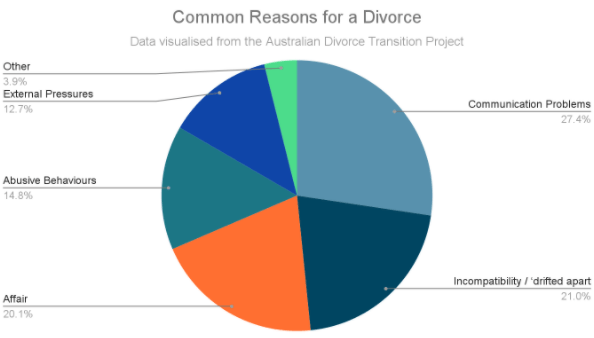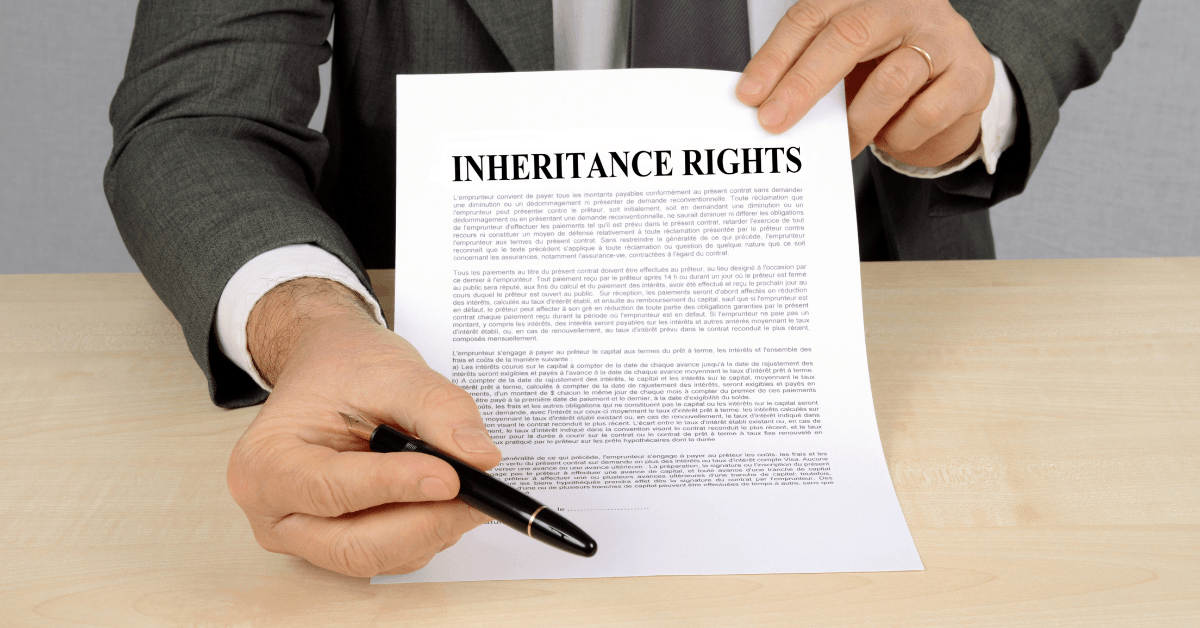The Divorce Process in Australia - Divorce Questions Answered
How to get a Divorce - Divorce Questions Australia
In this article we will answer your most common questions about the divorce process in Australia and explain the 5 step process in how to get a divorce.
The divorce process in Australia is not what you think.
Let me explain.
Many people looking to get a divorce believe it includes formal separation, property rights and parenting duties. Actually, divorce is the most straightforward aspect of the separation. It’s entirely separate from resolving financial issues, child support and dividing property.
Common Reasons for Divorce in Australia
While every divorce is unique to each relationship, in Australia there have been some more frequent reasons people apply for a divorce.
The Australian Divorce Transition Project asked people “What would you say was the main reason for your marriage ending? And here are the key results from their findings:
- 27.3% said “Communication Problems”
- 21.0% said “Incompatibility / ‘drifted apart’”
- 20.1% said “Your or former spouse had an affair”
- 14.8% was because of “Abusive Behaviours”
- 12.7% was because of “External pressures” like financial problems, work, mental health or family interference
- 3.9% was for other reasons.
Note: It should be noted that in Australia you don’t need a specific reason to apply for a Divorce. The only grounds for a Divorce in Australia is that there are irreconcilable differences between you and your partner which is made clear by at least 12 months’ separation. In Australia we operate under the “no-fault divorce” act established in the Family Law Act 1975.
How The Divorce Process Works in Australia
Being granted a divorce merely means the parties are no longer legally married. Chiefly an administrative process, either one or both parties must apply to the Family Court to obtain a divorce order. Please note, depending on your personal circumstances, you may be required to attend a short hearing.
The divorce order also incurs other important consequences in Family Law. The most important of which are spousal maintenance and property settlement. Additionally, it also triggers a statutory time limit to apply to the Family Court for spousal maintenance or property orders.
How to get a divorce in Australia: 5 Step Process
Step 1: Prepare your divorce papers
The first step of the process is to prepare your Application for Divorce document. You can either choose to file a joint application (you mutually agree) or a sole application where only you need to sign the application.
Do I need a lawyer to file for a divorce?
You can hire a private lawyer to prepare your divorce application and be your advocate during the divorce process, they will help you submit your divorce application and guide you through the legal steps leading up to the Divorce order from the Family Court.
A good private lawyer can provide legal assistance to your exact circumstances.
But you can also submit the application yourself, read the full guide on the Federal Circuit Court of Australia website.
Step 2: Sign your divorce papers
Once your divorce application is correctly prepared you will need to sign the document in front of a qualified witness. In Australia, the best thing to do is look up where your local Justice of the Peace is available to be a witness. If you are doing a joint application, this document needs to be signed by both parties.
Step 3: File your divorce application to the Family Court
Once the Divorce papers are filled and signed by a qualified witness, you’ll need to gather other supporting documentation like your marriage certificate.
Once you have done that you can submit your application at your local Family Court electronically by registering with the Commonwealth Courts Law Portal.
There is a divorce filing fee payable at the time of filing. You may be eligible for a fee reduction under certain circumstances.
Step 4: Receive the sealed documents & serve spouse documents (if needed)
Once you submit your Divorce application and the fee has been paid, the Court will begin to process your application and you will also be assigned a Court hearing date. As a part of the “processing” of the documents the Court will officially stamp the original document, which can be accessed through the Commonwealth Law Courts PortalThese stamped documents are called “sealed” documents.
The Court files away the original sealed application for records. In the case of a joint application, one of the sealed photocopies are sent to you and the other is sent to your spouse. In the case of a sole application, you will have to arrange to “serve” a sealed copy to your spouse (soon to be ex-spouse).
You will need to “serve” (deliver) the document to the other party at least 28 days before the court hearing date, unless your spouse is overseas. In that case, you need to serve your spouse 42 days before the court hearing date. There are specific court rules and forms required by the court for the “serving” of sealed divorce papers.
We recommend using a registered process server (also known as a service agent) to deliver the document to the other party. Otherwise, any person over the age of 18 years can personally serve the documents. You are not able to serve the documents yourself.
You must then file documents proving service upon your spouse. Divorce service kits can be found on the Family Courts website.
Step 5: Attend the court hearing
After the divorce application has been processed by the Family Court, you will receive a Court Hearing date. When you attend the Court Hearing, assuming all the required information is supplied, the Court will issue a Divorce order which will be in effect one month and one day from the hearing date.
It should be noted though, that there are circumstances where you are not required to attend the Court hearing. But you must attend the court hearing specifically if you filed a sole divorce application or there are kids under 18 involved. There are also other circumstances where you must attend so make sure you are aware of your obligations about attending the Court hearing.
Divorce Frequently Asked Questions (FAQ) in Australia
How to submit a divorce application in Australia?
There are a number of ways to submit a Divorce application in Australia.
- A private lawyer can help you fill out the application and submit it for you.
- You can also download and print off the application if you intend to do-it-yourself.
- You can also apply online through the Commonwealth Courts Portal, read this full guide.
Check out the full step by step Australian Divorce process above.
Divorce in Australia, who gets what?
This is a common misconception. Division of physical & financial property doesn’t happen during the Divorce process in Australia. After or before the divorce process is official you can apply for spousal maintenance and/or a property/financial order.
It is generally advisable to do so before the divorce to ensure you do not miss the time limit of 12 months to apply for property orders if negotiations fail.
It should be noted though, that time limits apply for matrimonial property settlement. You have only 12 months from the date of your Divorce to settle your property matters or apply to the Family Law Courts for orders. De facto couples have two years from the date of separation to do the same. To ensure you don't miss the time limit, you should obtain legal advice without delay.
Spousal Maintenance
But who gets what? In the case of Spousal Maintenance, the amount of financial support depends on what the main income producing party can afford.
Property Order
In the case of a property order, division of assets is usually based on an agreement between the two parties or after a court hearing. A property order can also be used for de-facto relationships maintenance.
This can be a complex topic, but the court takes into account:
- The value of all the property of both parties
- Assess the contributions of the parties (not just financially, but non-financial contributions such as caring for children or other responsibilities is also considered)
- Assess the needs of each party
- Identifies a just and equitable division
A 50/50 split that most of us assume is not actually common. It can take months to get all the information required for the court to make a fair and just decision.
If one of the parties is a business owner or part business owner the value of their share of the business will be considered as a part of the asset pool and a heavily negotiable item in the property settlement as there are many factors to consider. In this situation it is highly advised that you seek legal and financial advice.
How much does a divorce cost in Australia?
Submitting a Divorce application to the Family Courts does have a fee associated with it. Check out the exact figure under point 5 on the official how do I apply for a divorce guide. If you decide to also seek legal advice there will also be costs associated with the independent lawyer you choose.
Can divorce be denied?
The only reason a divorce can be rejected is if there was a procedural error or mishap in the application process. For example, there was something that was filled out incorrectly, or there was information that was not disclosed. Or perhaps the sealed divorce order was not “served” correctly. A divorce can also be denied due to jurisdictional issues - ie if the both parties are not Australian residents or it has not been 12 months and 1 day since separation.
To avoid your Divorce getting denied ensure you contact a divorce lawyer who can guide you through the process.
Does it matter who files the divorce application?
There are two types of divorce applications:
- Joint application where both parties sign and have a mutual agreement
- Sole application, where only one party signs
In the case of a sole application, the spouse who initiates the divorce process will control how fast the proceedings move and will be responsible for paying the divorce fee upon submission. They will also be responsible for legally serving the sealed divorce order documents to the other party using a process server.
How long do you have to be married before you can file an application for divorce?
In Australia, you have to be married for at least 2 years before you can apply for a divorce. See the question below on what to do if you have been married for less than 2 years.
What should you do if you’ve been married for under two years?
If you’ve been married two years or less, you must undergo compulsory mediation, provided by a Family Court-approved child and family mediator. The purpose is to discuss a possible reconciliation. Then, with a certificate issued by the counsellor, you can file an application.
However, if you or your spouse cannot attend counselling, you must outline the reasons in an affidavit, submitted with the application. If you’re close to the two-year threshold with no mitigating circumstances, we recommend waiting for the deadline to expire.
How long do you have to be separated for?
In Australia, you have to be able to show that you have been separated from your spouse for 12 months and 1 day. Ideally you would be living in different locations and have not spent social time with each other to be considered separated in that time. The Court will look at the evidence to decide.
What if we’re separated but living under the same roof?
You can cohabitate, but you must prove the marital relationship is completely broken down. This will generally involve providing Affidavits to the Court setting out the evidence proving that you and your spouse have been separated but living under the same roof.
This can get a bit more complicated as the Court will have to look at quite a few factors for you to be considered separated for 12 months. The things they will look at include:
- Financial Arrangements like who is providing financial support, tax reporting, sharing a bank account or not etc.
- Household living arrangements (sharing a bedroom, who does the chores, do you socialise with each other)
- Intimate Relations
- Other social aspects, like do you still present as a couple in public, have you told your family etc.
- Evidence from a third party that the marriage is over
Note: This is not an exhaustive list.
In this situation it’s important to seek legal advice so you can safely identify if you can be considered separated for the adequate period of time.
How to get a divorce if you don’t have a marriage certificate?
It is Australian law to submit your application with your marriage certificate, however there are some individual circumstances where that might not be possible. For example, if you were married overseas or lost your marriage certificate. In this situation you’ll need to submit a “Affidavit in Lieu of Marriage Certificate”. Which is a formal statement which demonstrates to the Court that your marriage is valid. You will need to show in the Affidavit that you have done your best to find a replacement and that your marriage is valid under Australian law. Read more here.
If you were married overseas and your Marriage Certificate is not in English, you will need to have your Marriage Certificate translated by a certified translator service.
How long does divorce take?
Generally speaking, it takes approximately four months from the filing of a Divorce Order for it to be finalised. A divorce is generally finalised one month and one day after it is granted Once your divorce is finalised you can print a digital divorce order from the Commonwealth Courts Portal on the next working day.If planning to remarry, or you can’t locate your former spouse, allow more time for it to go through.
What are valid grounds / reasons for divorce in Australia?
The only reasonable grounds for divorce in Australia are irreconcilable differences, made clear by at least 12 months’ separation.
For a successful application, you must:
- Prove the marriage is irretrievably broken (i.e. through a minimum 12 months’ separation)
- Have been married for at least two years, or undertaken necessary counselling in the Family Court
However, if you and your partner have reconciled for three months or more, the 12-month separation period starts again.
Can either party oppose the divorce?
In some rare cases, a party can oppose a divorce. The key reasons are: disputing whether the date of separation meets the 12-month requirement or divorce proceedings may be underway overseas or that the Court does not have jurisdiction.
Failure to agree on property settlement or parenting arrangements isn’t grounds for divorce. If your partner opposes the divorce, they must file a response application. This must be served to you or your lawyer before the hearing.
What should I do if I can’t locate my spouse to serve the application?
In this case, you can still apply to the Court. However, you must prove you have endeavoured to locate your spouse. Should their address not be found, you can file an Application for Substituted Service. This application can then be served by alternative means, such as on a family member or by , by is served to a family member of your spouse on their behalf. If successful, the Court allows documents to be served to said family member via electronic means (i.e. email or Facebook).
Keep in mind, the extra legal work involved increases your costs and delays the final Divorce Order.
What impact will the divorce have on my children?
Children’s arrangements are finalised prior to the actual divorce. If your children are under 18, the Court must ensure sufficient provisions have been made for their welfare. This doesn’t mean parents can’t argue over parenting arrangements. It simply means the children’s physical and emotional wellbeing is maintained.
Parties often attend mediation to determine post-separation parenting arrangements. This is a mandatory step before initiating parenting proceedings in the Family Court. Parents can enter a Parenting Plan to document their agreement, or select a legally binding option like an Application for Consent Orders.
Whilst parenting matters are separate from divorce, the Court required parenting arrangement information (including their education, health and care) as part of the Divorce Application. Even if some aspects are being contested, the Judicial Officer must be satisfied at the Divorce Hearing that appropriate arrangements are in place before the divorce order.
If I was married overseas, can I get a divorce in Australia?
Provided they have the jurisdiction to hear the Application, the Family Court can dissolve overseas marriages. The Court may do so if you are:
- An Australian citizen (by birth, descent or grant), a permanent resident, or;
- Consider Australia as your home and intend to stay indefinitely
Upon meeting these conditions, you can apply for a divorce in Australia, if you have a copy of your overseas marriage certificate. If the copy of your marriage certificate is in a foreign language, it must be translated and this translation filed with the Divorce Application.
Should I apply for divorce jointly?
Yes, as these are quicker and more cost-effective. A joint application incurs no service fees, and if you have children under 18, they are dealt with in chambers. This means lawyers don’t need to attend the divorce hearing and legal fees are reduced.
How does divorce impact my property rights?
As already mentioned, a divorce does not determine your property entitlements. The reason being, property settlement is much more complex than a divorce application. The only connection between them is your property settlement has to be filed within 12 months of your divorce finalisation. It is therefore advisable to commence property settlement negotiations prior to applying for divorce. Parenting arrangements can be finalised at any stage after separation.
What impact does divorce have on my will?
Upon divorce, any gift left to your spouse becomes invalid. Therefore, both parties should make separate wills to reflect your wishes. We also recommend removing your spouse as beneficiary to your superannuation and life insurance benefits. If you haven’t updated your will since separation, we recommend obtaining Will and Estate Planning advice.
Perhaps also note that a Power of Attorney is automatically revoked upon Divorce.
Summary
In summary, divorce is simply the final step in dissolving your marriage and doesn’t involve the division of assets, that comes after the official Divorce Order. To ensure your application is successfully filed and accepted by the Family Court, get in touch with KMB Legal today, we can provide a friendly face to help through the whole process.






